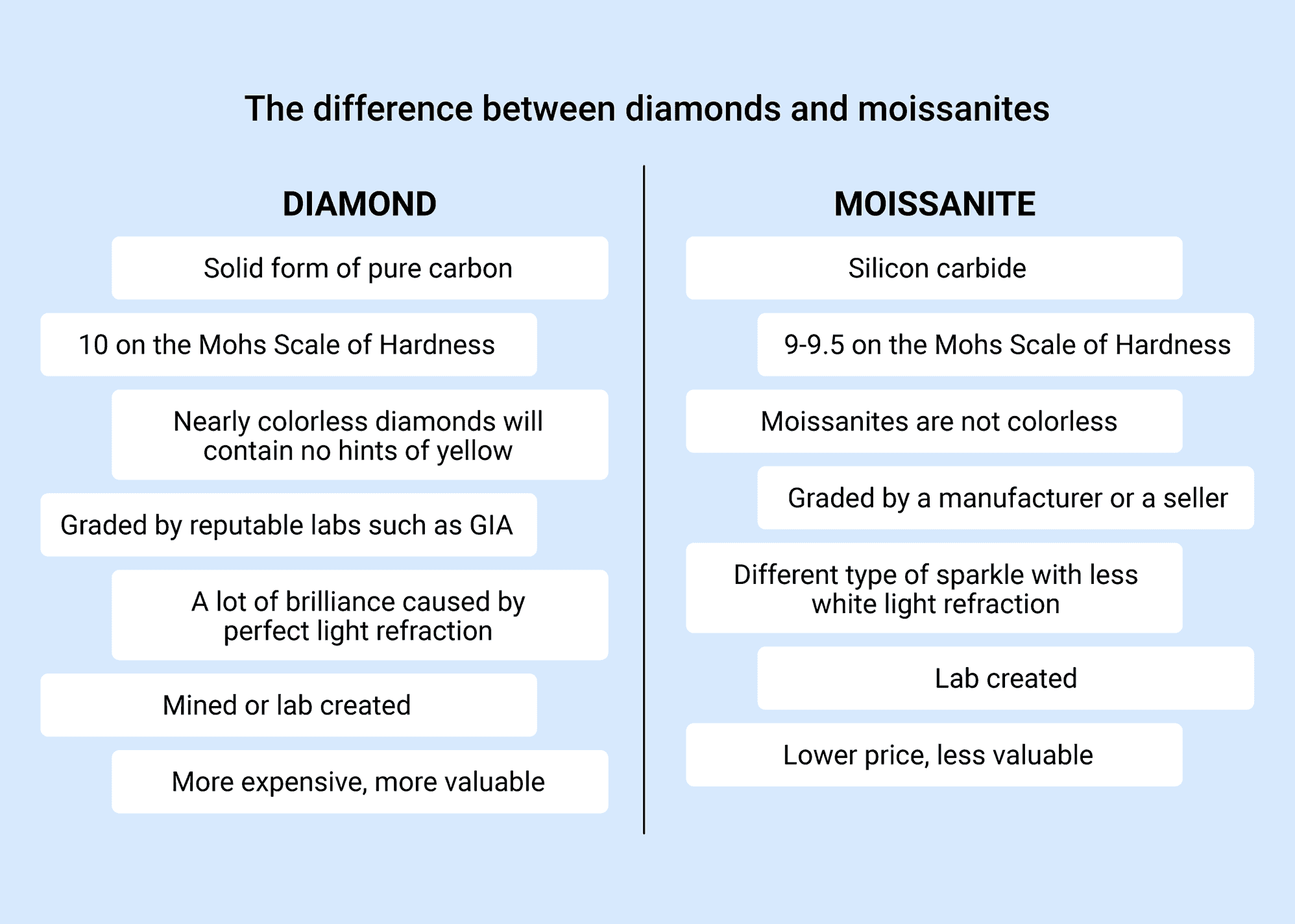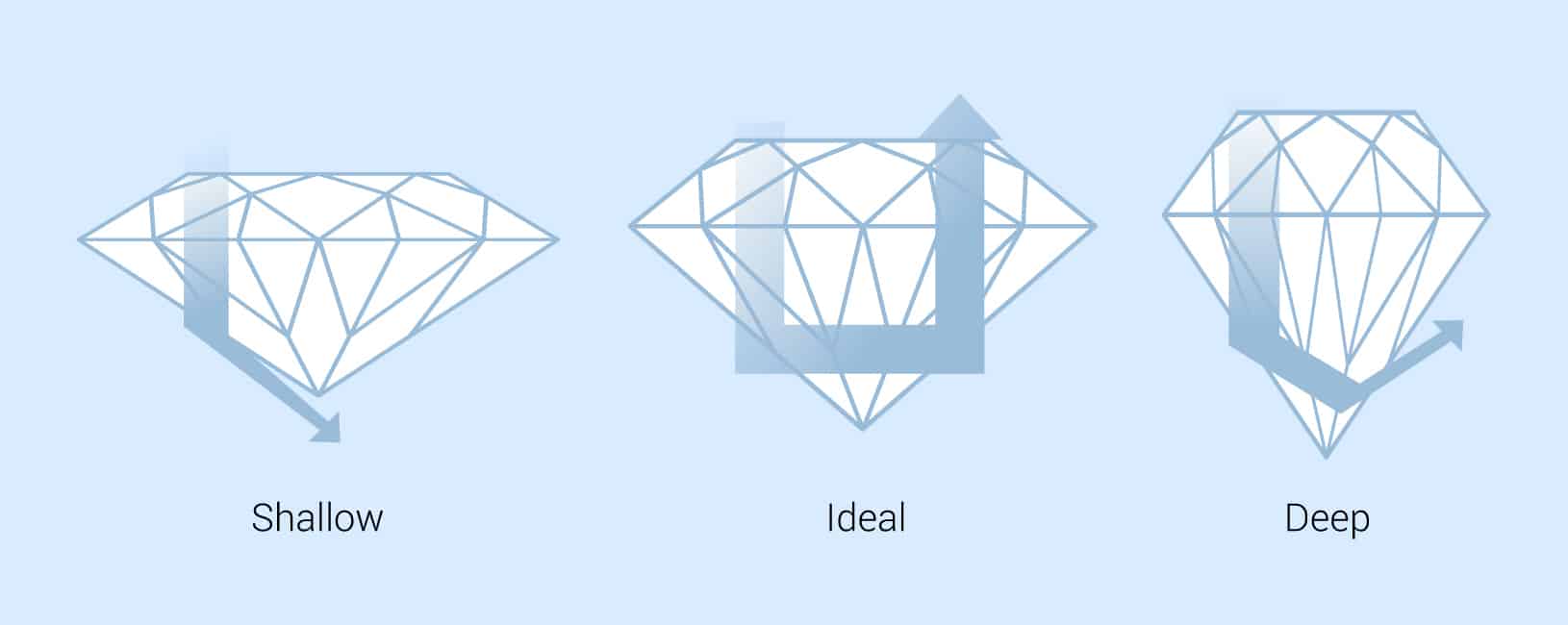Moissanite vs. Diamond: What are the differences?
Difference between them and why diamonds are worth the money
Difference between them and why diamonds are worth the money
While the two gemstones may appear similar and even share many properties, diamonds and moissanite have several key differences that set them apart.
Moissanite vs. Diamonds: Key Differences

What is moissanite?
Diamond vs. moissanite: Price
Diamond vs. moissanite: Color
Diamond vs. moissanite: Clarity
Diamond vs. moissanite: Cut
Diamond vs. moissanite: Hardness
Best moissanite engagement rings
Diamond vs. moissanite: Brilliance
Can moissanite be considered a diamond?
How to tell the difference between moissanite and diamond
Advantages of moissanite over diamonds
Disadvantages of moissanite over diamonds
Other alternatives to diamonds
FAQs
Bottom line recommendation
Moissanite is a near-colorless gemstone that’s composed of silicon carbide. First discovered by Henri Moissan, a French scientist, moissanite was originally found in the crater left behind by a fallen meteor.
Although they look similar at first glance, moissanite is very different from a diamond. Diamonds are made of carbon, whereas moissanites are made of pure silicon carbide — an extremely rare, naturally-occurring mineral.
Why you should trust us
The natural moissanite discovered by Moissan in 1893 is exceptionally rare, making it practically impossible to use natural moissanite for jewelry. As such, the moissanite sold today is produced by laboratories.
Although it’s made to seem like diamonds, moissanite varies from diamond in both composition and in appearance.
The price and value is dependent on the diamond 4 C’s (cut, color, clarity and carat). These elements work together to form the beauty and brilliance of the stone. Because diamonds are mostly natural rather than artificial, they can vary hugely in price, value and quality.
On the other hand, most moissanites tend to cost the same price, except when two stones differ in size and type of moissanite material—enhanced or unenhanced.
While price differs between diamond and moissanite, it’s essential to realize that the features, quality and beauty of diamonds and moissanites differ significantly. Just because the price is lower, it does not mean you’re getting a better deal or a better value.
To outline the price difference of moissanite vs. diamond side by side, we’ve compiled the below chart. Although the prices differ, the lasting value and actual beauty of a moissanite vs. diamond is incomparable.
Note: Moissanite weighs approximately 15% less than diamonds. Therefore, an accurate comparison of price is not possible. Instead of using Carat weight, moissanites are priced on their size in millimeters. We have estimated a close comparison below.
| Size (in Carats) | Diamond Price | Size (closest equivalent to Carats) | Moissanite Price |
|---|---|---|---|
| 0.50 | $1,060 | 5mm | $520 |
| 0.63 | $1,520 | 5.5mm | $610 |
| 0.75 | $2,220 | 6mm | $680 |
| 1.00 | $3,890 | 6.5mm | $850 |
The table above shows a comparison between diamonds in various carat weights and moissanite stones in roughly corresponding sizes.
At the low end, you can see that a half-carat diamond costs more or less twice as much as a similarly sized moissanite. And this price ratio increases with size too, with a 6.5mm moissanite stone costing around $850 which is 80% less than a 1ct diamond with a similar diameter.
Although moissanites and diamonds can look similar in color when seen from a distance or in poor lighting, there are significant color differences between them that are more obvious when the two are viewed up close.
Diamonds are graded on a GIA diamond color scale from D to Z, while moissanites are not categorized by their color. Moissanites are, however, not colorless and resemble the K grade on the GIA color scale used to grade the color of diamonds.
When under certain lights, yellow and green tints can be seen in moissanites. The larger the moissanite, the easier it is to notice yellow, gray or green tints. At large sizes, it’s generally easy to notice the stark difference from a diamond.
Nearly colorless diamonds, ranging from D to J on the GIA scale, will contain no hints of yellow or gray tinting. Color is one element that make diamonds sparkling white, and it is hard to mistake a moissanite for the clear, natural beauty of a diamond.
Over the years, there have been various efforts to produce artificial moissanites that were free of color. If you’ve looked into moissanite jewelry, you might have heard of the Forever Brilliant moissanite produced by Charles & Colvard.
Forever Brilliant was the first of several colorless-looking moissanites produced by Charles & Colvard. The Forever Brilliant brand has since been discontinued, but you can still track down information on these moissanites online.
Essentially, these moissanites were slightly more colorless than the conventional manmade moissanites used in rings and other jewelry. However, due to technological limitations, they weren’t completely free of color like a diamond.
Estimates for the approximate GIA diamond color grade of a Forever Brilliant moissanite can vary, although most diamond experts estimate that they’re roughly equivalent to a diamond in the G to I range. (Forever Classic, another range of moissanites, are closer to J to K.
Charles & Colvard followed up the Forever Brilliant moissanite with Forever One — a newer, more advanced colorless moissanite — in 2015.
Forever One moissanites are marketed as the company’s high-end moissanite line. They’re promoted as hand-cut, flawless and made using the finest moissanite rough available. They claim to be totally colorless, equivalent to a D, E or F GIA diamond color grade.
In terms of color, Forever One moissanites are certainly closer to being colorless than older “colorless” artificial moissanites such as Forever Brilliant. With this said, the equivalent color grades used for these stones aren’t always a very accurate or useful comparison.
These moissanites also differ from diamonds in several noticeable ways. Silicone carbide is a very different material from diamond, meaning it displays color differently and disperses light in a different pattern. Ultimately, even a Forever One moissanite won’t look like a diamond.
The clarity of a moissanite refers to the amount (or lack of ) blemishes and inclusions that are visible in the stone. Like diamonds, moissanites are generally imperfect, meaning they’ll often have small blemishes that are visible when they’re viewed under magnification.
Almost all moissanites sold are graded for clarity using a scale similar to that used by the GIA (and other grading entities) to assess diamond clarity.
It’s important to note that the clarity grade for a moissanite isn’t given by the GIA, AGS or any other impartial gemological lab — instead, the clarity grade (and certificate, if the moissanite is sold with one) is often given with the stone by its manufacturer or seller.
Since moissanites are artificial, unlike natural diamonds, it’s very uncommon to see moissanites with a clarity grade below the VS level for sale. In general, the clarity of a moissanite is close to flawless almost all the time.
Like diamonds, moissanites are available in a variety of different cuts. You can find round, oval, pear, cushion, princess and radiant cut moissanites. Some moissanites are even cut in antique cuts that were widely used for diamonds hundreds of years ago.
The most popular cut for moissanites is the round brilliant cut. There are several reasons for the round brilliant cut’s popularity:

Generally, moissanites look the best in cuts that hide color and emphasize the stone’s brilliance, such as the princess cut (for moissanites, this shape is often referred to as the “square cut”), as well as the oval cut, radiant cut and marquise cut.
On the Mohs scale of hardness, a moissanite measures in at 9.25, while a diamond has a score of 10 — the maximum on the scale.
The Mohs scale is used to measure a gemstone’s hardness, or in other words, its durability. The scale ranges from 1 as the softest to 10 as the hardest. The Mohs scale shows one of the most obvious distinctions between a moissanite and a diamond.
As the hardest known mineral,diamonds are incredibly durable and resilient. This makes them perfect for everyday wear and engagement rings, as they’re able to resist scratches and other damage that could affect the appearance of softer stones.
To gain perspective on mineral hardness, we display the Mohs scale below. As the chart demonstrates, diamonds are harder than some very durable minerals such as steel and Tungsten carbide.
Now, does this mean that moissanites scratch? Not quite. Although moissanite is lower on the scale than a diamond at 9 to 9.5, moissanites are still durable. The only minerals that scratch a moissanite are those equal or higher on the scale — namely, diamonds and other moissanites.
| Hardness | Substance or mineral |
|---|---|
| >10 | Nanocrystalline diamond (hyperdiamond, ultrahard fullerite) |
| 10 | Diamond |
| 9.5–10 | Boron |
| 9–9.5 | Moissanite |
| 9 | Tungsten carbide |
| 8.5 | Chromium |
| 8 | Cubic zirconia |
| 7.5–8 | Emerald |
| 7 | Quartz |
| 6–7 | Silicon |
| 6 | Titanium |
| 5.5 | Glass |
| 5 | Apatite (tooth enamel) |
| 4–4.5 | Steel |
| 4 | Iron |
| 3.5 | Platinum |
| 3 | Copper |
| 2.5–3 | Gold |
| 2–2.5 | Halite (rock salt) |
| 2 | Calcium |
| 1.5 | Lead |
| 1 | Talc |
| 0.5–0.6 | Potassium |
| 0.2–0.3 | Rubidium |
Here are some Moissanite Engagement Rings for your inspiration:
Solitaire Rings
Side-Stone Rings
HaloRings
Vintage Rings
When you see a diamond sparkle, you’re experiencing its ability to bend and refract light. As light strikes the pavilions (the angled surfaces on the lower half of the diamond), it bounces and is refracted up through the diamond’s table (the top, flat surface) to your eye. When this occurs, it’s called brilliance—a remarkable quality of diamonds.
Moissanites, on the other hand, give off a different type of sparkle. Their facets are cut and formed differently, causing less white light refraction than a diamond. While moissanites do create sparkle, it is not as clear and vibrant as those of a diamond.
Interestingly, moissanites have a higher refractive index — a measure of the speed at which light travels through the material — than diamonds. The refractive index of moissanite is 2.65, versus 2.42 for diamonds. Overall, the refractive index of the two stones is very similar.
In addition to diamond’s signature brilliance, the gemstones also emit fire, which is the reflection of colored, or rainbow light. A moissanite also gives off a vibrant colored light reflection. In some cases and under certain light, the moissanite emits extensive color dazzling—which some people don’t prefer.
While relatively noticeable when looking at a moissanite vs. diamond side by side, the difference in brilliance and fire is increasingly obvious with larger sizes, especially when the gemstones are viewed up close in certain lighting conditions.
By both experts and non-experts, moissanites should not be considered the same as a diamond. The two are entirely different gemstones for several reasons, from substance to brilliance to color.
Diamonds are naturally found, formed of the hardest material, and possess extraordinary beauty and value. Moissanites are almost always lab-created and made from silicon carbide. They also have numerous visual differences from diamonds, such as color and light performance.
While from a distance the diamond and moissanite might appear somewhat similar, they are noticeably distinct even to a non-expert’s eye.
Now, does this mean that a moissanite is better than a diamond, or worse? That’s ultimately a subjective question that no one can answer. A moissanite isn’t better or worse than a diamond (and vice-versa) — instead, they’re very different stones with different characteristics.
From a distance, moissanite and diamond can look quite similar, especially when each stone is inside an engagement ring or other piece of jewelry. With this said, there are several ways that you can tell moissanites and diamonds apart when they’re viewed up close:
GIA, the world’s leading diamond grading laboratory published an article about how some people tend to cheat the system and sell moissanites as diamonds. Luckily for consumers, they usually get caught pretty quickly. JCK Online also reports of cases where fraudulent merchants were coating moissanites with a thin diamond film and claimed these were “challenging to identify.”
Moissanites offer several unique advantages over diamonds, although these may not be seen as advantages for everyone:
Despite their advantages, moissanites also have several unique disadvantages when compared to diamonds:
Moissanites are often viewed as a cost-effective alternative to buying a diamond. If you want to purchase an engagement ring but aren’t totally sold on a diamond, you might want to keep the following alternatives in mind:
Unlike cubic zirconia, which can degrade in appearance over time, moissanite does not become cloudy with age.
Over time, dirt, oils and other substances can build up on the surface of a moissanite, making it appear cloudy. However, this can be cleaned away without affecting the true appearance of the stone.
Yes. Moissanites are strong, long-lasting gemstones. A moissanite should last for your entire life without losing its appearance or becoming damaged. If you choose a setting that’s made from a high-quality metal such as platinum or gold, a moissanite ring will last for a very long time.
In its natural state, moissanite comes from space. As we mentioned above, moissanite was first discovered by Henri Moissan in Arizona more than a century ago, inside the crater that was left behind when a meteor landed on earth.
Natural moissanite deposits have also been found around the world in Wyoming and in certain parts of Russia. However, due to the limited supply of naturally-occurring moissanite on earth, the moissanite used for jewelry is produced artificially in a laboratory environment.
Though moissanites and diamonds are unmistakably different, the moissanite is an option for those looking for a gemstone at a lower price point. Because we are diamond experts and not moissanite experts, we, unfortunately, aren’t able to recommend a moissanite retailer.
If you’d like to consider a high-quality diamond at an excellent price—that will maintain its beauty and value over the long run—contact our experts today. We can begin a complementary search for you and walk you through everything you need to know. We’ll keep your budget, desires and concerns in mind.
If you are looking for a cheaper alternative to natural diamonds, we would recommend going the lab-grown-diamond route. You can find a stunning lab-grown diamond from James Allen or Blue Nile for a fraction of the cost of a natural diamond. Take this stunning 2.01ct diamond from James Allen for example. It has the exact same physical properties of a natural diamond but is more than 60% cheaper.
While moissanite and diamond have somewhat similar appearances from afar, the two stones differ significantly in several areas like brilliance, fire, durability and value. You can find a moissanite ring like this on Amazon for a fraction of the cost of a diamond ring, but it’s important to know the main differences—and in this guide, we’ll share everything you need to know.




Before you buy a diamond, get personal buying advice from industry veterans. We'll help you get the best diamond for the money.
DISCLAIMER: We don't use your email for marketing. Period.
A diamonds’ price is determined primarily by the 4 Cs of the diamond. On the wholesale level, diamond prices are first based on a diamond shape and
Buying an engagement ring is often one of the first major purchases in a person's life. The process can be fraught with tension as there are so m
A wide range of 1 carat diamonds exist both in online markets and local diamond jewelry stores. Not only are there significant differences in beauty
Please enter your email address to receive your 25% off coupon code:
Here is your coupon code: GFDSF3GF